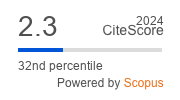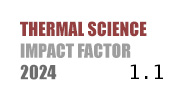THERMAL SCIENCE
International Scientific Journal
AERODYNAMIC ANALYSIS OF FIELD WIND TURBINE: A COMPARATIVE STUDY OF COMPUTATIONAL METHODS WITH EXPERIMENTAL VALIDATION
ABSTRACT
The study compares performance predictions from blade element momentum theory, CFD methods, and experimental results for a 2.5 MW horizontal wind turbine across various wind speeds. The results indicate that CFD or in complex flow conditions, although blade element momentum theory remains useful during the initial design stages. The analysis also underscores the influence of wind speed and shear stress transport on performance metrics such as turbine power output and flow characteristics. Despite certain modelling simplifications, such as the omission of detailed blade tip geometryies, the findings suggest that both numerical methods exhibit trends consistent with the field experimental data. The study highlights the importance of detailed simulations for optimizing wind turbine performance and outlines future research focused on noise reduction and its impact on biodiversity.
KEYWORDS
PAPER SUBMITTED: 2024-09-30
PAPER REVISED: 2024-10-20
PAPER ACCEPTED: 2024-11-04
PUBLISHED ONLINE: 2024-12-07
THERMAL SCIENCE YEAR
2025, VOLUME
29, ISSUE
Issue 2, PAGES [1607 - 1618]
- Manwell, J. F., et al., Wind Energy Explained: Theory, Design and Application, John Wiley and Sons Ltd., Chichester, UK, 2009
- Jonkman, J., et al., Definition of a 5-MW Reference Wind Turbine for Offshore System Development, National Renewable Energy Laboratory, Golden, Col., USA, 2009
- ***, Global Energy Transformation: A Roadmap to 2050, International Renewable Energy Agency, www.irena.org/publications/2019/Apr/Global-energy-transformation-A-roadmap-to-2050-2019Edition, 2019
- Betz, A., Wind-Energie und ihre Ausnutzung durch Windmühlen (Wind energy and its utilization through windmills - in German), Vandenhoeck & Ruprecht, Goettingen, Germany, 1920
- Joukovski, V., Theoretical Studies on the Aerodynamics of Wind Turbines, 1920
- Glauert, H., The Elements of Aerofoil and Airscrew Theory, The University Press Cambridge, Cambridge, UK, 1948
- Sorensen, J. N., Aerodynamic Aspects of Wind Energy Conversion, Annual Review of Fluid Mechanics, 43 (2011), 1, pp. 427-448
- Sorensen, J. N., General Momentum Theory for Horizontal Axis Wind Turbines, Springer, Cham, Switzerland, 2016
- Sorensen, J. N., Aerodynamic Analysis of Wind Turbines, in: Comprehensive Renewable Energy, Elsevier, Amsterdam, The Netherlands, 2022, Vol. 2, pp. 172-193
- Abobark, A. T., et al., Computational Fluid Dynamics (CFD) Investigation of NREL Phase VI Wind Turbine Performance Using Various Turbulence Models, Processes, 12 (2024) 9, 12091994
- Pajčin, M. P., et al., Comparative Analysis of Numerical Computational Techniques for Determination of the Wind Turbine Aerodynamic Performances, Thermal Science, 25 (2021), 4A, pp. 2503-251
- ***, Eolos Wind Research Station, University of Minnesota, [Online], Available: eolos.umn.edu/eolos-wind-researchstation
- ***, ANSYS® [version 18], ANSYS, Inc. Available at: www.ansys.com
- Marten, D., Wendler, J., The QBlade: An Open Source Tool for Design and Simulation of Horizontal and Vertical Axis Wind Turbines, International Journal of Emerging Technology and Advanced Engineering, 3 (2013), 3, pp. 264-269
- Hercules, A. O., et al., Assessment of Correction Methods Applied to BEMT for Predicting Performance of Horizontal-Axis Wind Turbines, Sustainability, 15 (2023), 8, 7021
- Sithole, T., et al., Optimizing Small Wind Turbine Blades: A BEMT Approach, International Journal of Energetica, 8 (2023) 2, pp. 36-43

